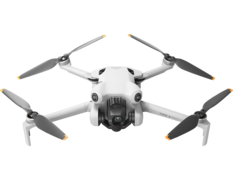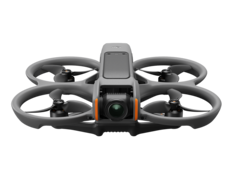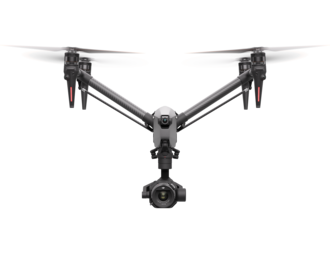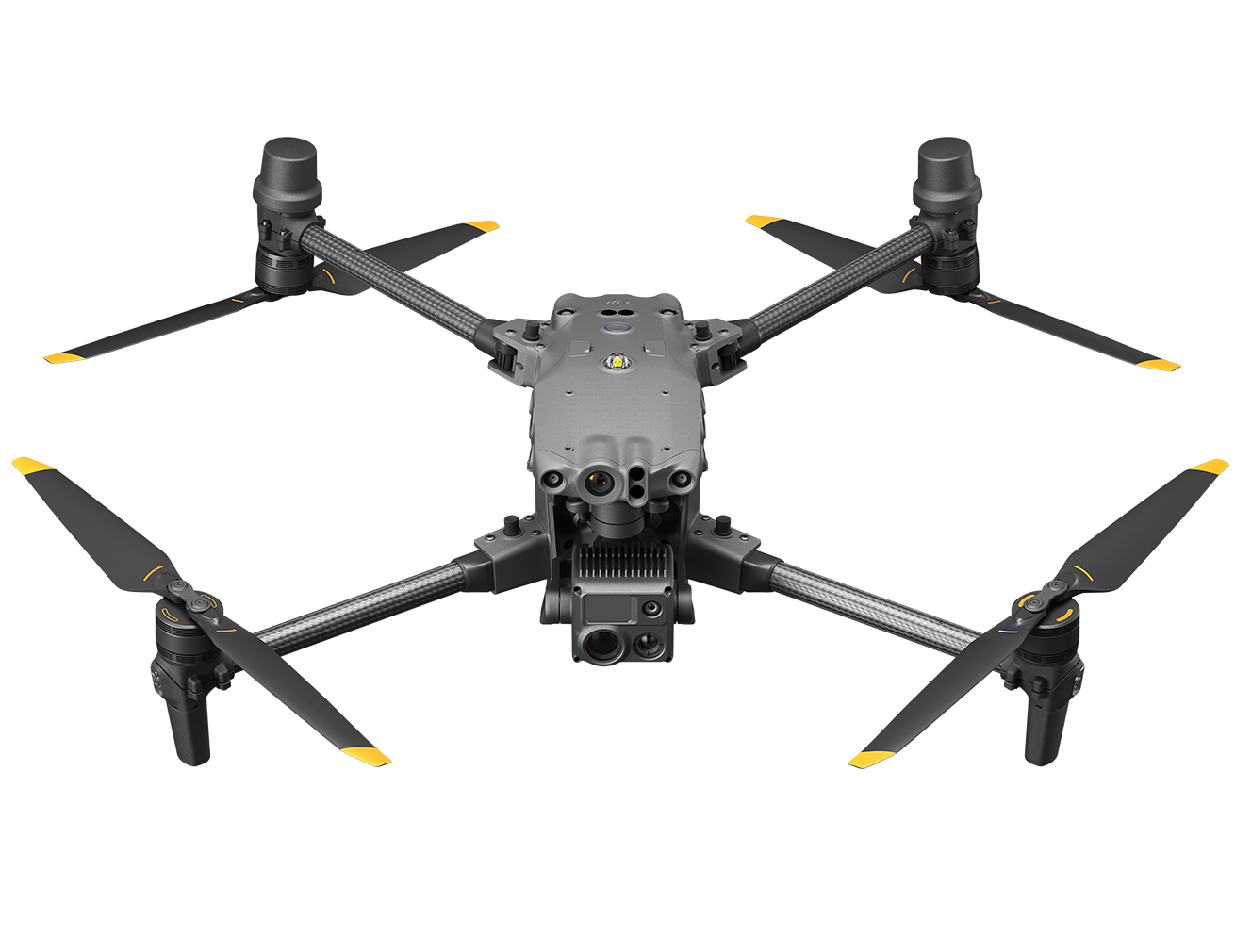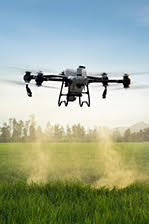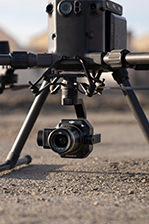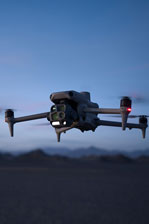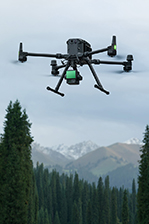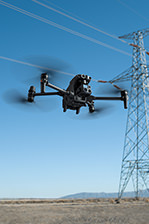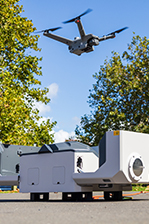Features
Vision Beyond Boundaries
DJI Transmission evolves from the established DJI aerial video transmission technology, delivering an integrated solution that combines a video receiver, monitor, controller, and recorder. It is designed for native integration with Ronin-series products and DJI Master Wheels, transforming the industry with a groundbreaking transmission experience that provides vision beyond boundaries.
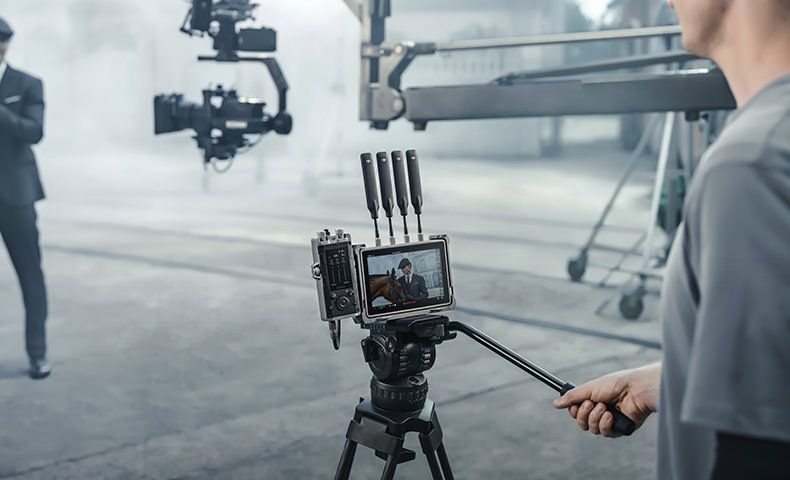
Transmission Performance
Long-Distance HD Live Feed
DJI Transmission incorporates O3 Pro video transmission technology, which offers an incredible 6km/20,000ft [1] on-ground transmission distance. It also supports transmission at 1080p/60fps with a max bitrate of 50Mbps as well as live audio monitoring at 16-bit 48 kHz, providing crews on large sets with an excellent remote visual and audio monitoring experience.
End-to-End Ultra-Low Latency
The video transmitter and receiver use the same chip solution as Ronin 4D, with every link explicitly optimized to provide end-to-end ultra-low transmission latency when pairing with cinema cameras like ALEXA Mini LF.
Seamless Auto Frequency Hopping
O3 Pro adds DFS bands on top of the traditional 2.4 GHz and 5.8 GHz frequency bands, offering up to 23 channel options that provide professional crews with more compliant and interference-free transmission channels. In addition, DJI Transmission supports triple-band automatic frequency hopping, which automatically scans the electromagnetic environment for the best wireless channel.
With a built-in frequency sweeper, users can even manually select the optimal channel to avoid interference between devices.
By mounting high-gain antennas, [2] transmission capability is further boosted.
One Transmitter with Multiple Receivers
The High-Bright Remote Monitor supports one transmitter with multiple receivers for video and audio feeds in two transmission modes. In Control mode, DJI Transmission delivers optimal transmission performance. Monitoring can be done from two receivers at the same time, while Ronin 2, RS 3 Pro, and camera focus can all be controlled remotely.
For crews operating with multiple members and teams, such as lighting, art department, and props, Broadcast mode can be enabled on top of Control mode to allow an unlimited number of receivers (transmission performance differs from Control mode). This brings shooting efficiency and awareness to an entirely new level.
In dynamic, multi-team environments such as reality television sets, DJI’s unique transmission protocol can make better use of wireless channels. With DFS bands and seamless automatic frequency hopping technology, DJI Transmission can operate with 20 or more transmitters sending signals to 20 or more monitors simultaneously. This results in a smooth, coordinated experience that's difficult to achieve with traditional transmission setups.
Encrypted Transmission
DJI Transmission supports secure pairing and AES 256-bit encryption to protect against unauthorized access to your information. Together with DJI’s self-developed chip and transmission protocol, DJI Transmission is able to ensure the highest level of security for your footage.
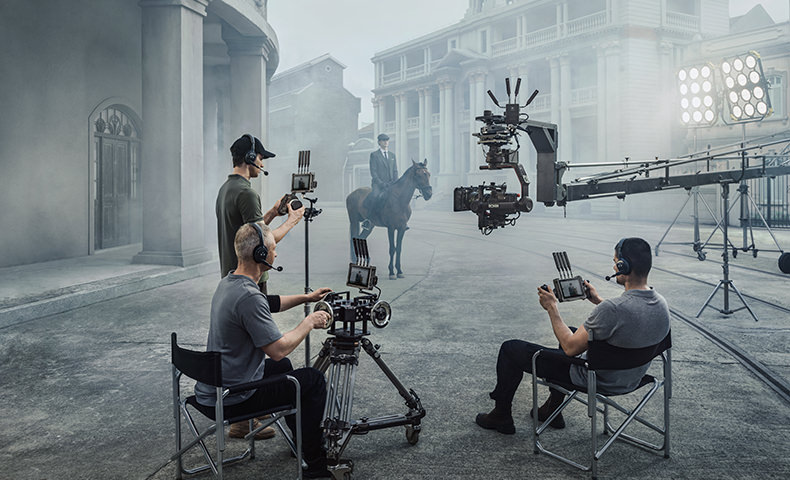
Monitoring Experience
Integrated Design
Compared with conventional solutions, DJI Transmission integrates a high-bright monitor with a built-in receiver, providing optimum portability and efficient setup to help you get started fast in any setting.
The remote monitor comes with a built-in image processing chip that is the same as the one used on Ronin 4D. This allows it to offer many features in addition to monitoring for integrated and efficient receiving, monitoring, control, and recording.
Wide-Gamut Touchscreen
The High-Bright Remote Monitor is equipped with a 7-inch wide-gamut touchscreen with a brightness of up to 1,500 nits. It comes standard with a tempered glass screen protector and professional monitor hood to deliver rich, true-to-life colors, even in strong lighting conditions. With a 1920×1200 resolution, the screen displays a non-intrusive interface (OSD), with visible details like shooting parameters to ensure easily accessible information and seamless monitoring.
Supportive Tools
The remote monitor comes with supportive tools like safe zone, frame guide, zebra stripes, false color, peaking, and waveform for precise composition, exposure, and focusing.
Independent Recording and Playback
The remote monitor also features a microSD card slot and allows for recording and playback of a 1080p/60fps H.264 live feed, as well as simultaneous access to video timecodes, making it easy to edit proxies right on set. When several remote monitors are used in conjunction, each monitor can even record or playback footage independently without interfering with other monitors.
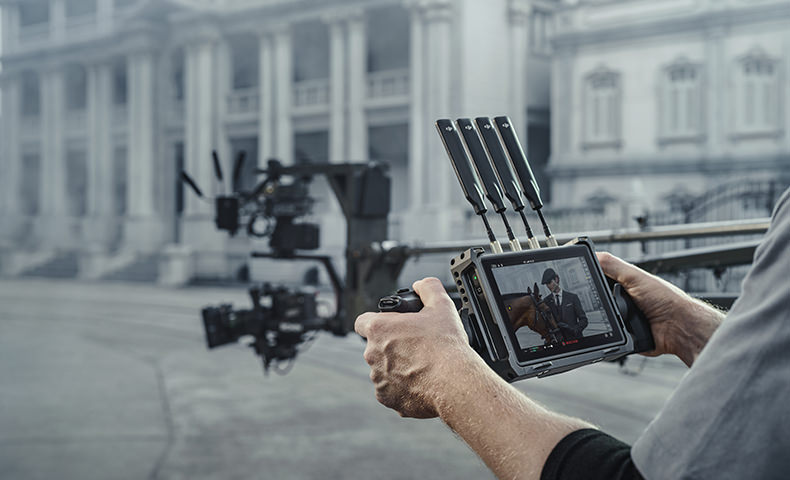
Expansive Control Options
Built-In Motion Controller
The High-Bright Remote Monitor has a built-in gyroscopic sensor that enables it to act as a standalone motion controller for Ronin 2 or RS 3 Pro without the need for additional accessories. This allows users to achieve more complex camera movements from a moving vehicle or with a jib.
Compatible with Ronin 4D Hand Grips
The High-Bright Remote Monitor comes with an expansion-protective frame. When using with Ronin 4D Hand Grips, [2] the joystick can control the Ronin 2 or RS 3 Pro gimbal, and the focus wheel can control focusing and the adjustment of camera parameters like aperture, shutter, and ISO, while the record button controls start/stop of recording, [3] making the RS 3 Pro user experience similar to that of Ronin 4D.
Compatible with DJI Master Wheels and DJI Force Pro
When used with the DJI Master Wheels or DJI Force Pro, [4] the remote monitor allows users to achieve more advanced gimbal control when using Ronin 2 or RS 3 Pro. In this scenario, the original equipment will transmit control signals directly through DJI Transmission, no longer utilizing the wireless signals from DJI Master Wheels or DJI Force Pro. This boosts the transmission performance by three times and enhances signal range, stability, and anti-interference capabilities.
Mirror Control Mode
When RS 3 Pro is mounted to jibs, cable cams, and vehicles, with Mirror Control mode, [5] you can remotely control the menu of Sony mirrorless cameras from anywhere on set.
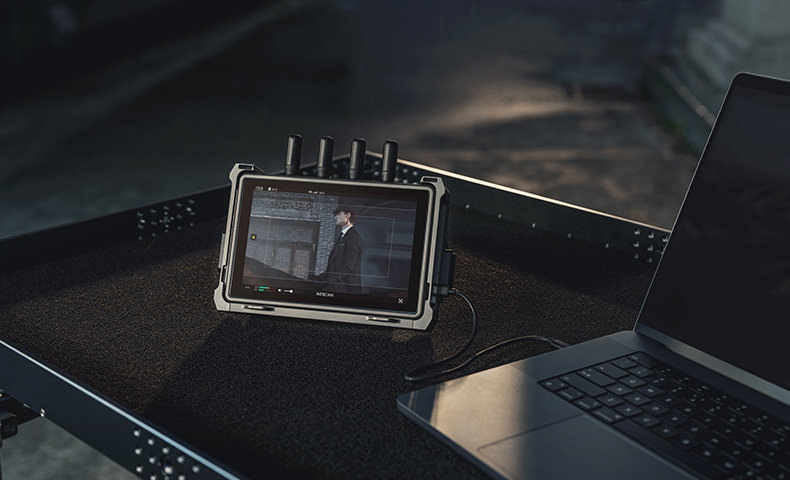
Ports and Power Supply
4D Video Transmitter Port
3G-SDI Loop Out Port
Supports output of 1080p/60fps videos.
3G-SDI Input Port
Supports input of 1080p/60fps videos.
HDMI 1.4 Type-A Input Port
Supports input of 1080p/60fps videos.
High-Bright Remote Monitor Ports
3.5mm Stereo Jack
Monitors audio in real time.
microSD Card Slot
For internal recording and playback on the monitor.
HDMI 2.0 Type-A Input Port
Supports input of 4K/60fps videos.
USB Type-C port
For firmware updates.
Power Input Port
6.8 V to 17.6 V power input (including CAN input and output, and connection with DJI Master Wheels and DJI Force Pro). [4][6]
HDMI 1.4 Type-A Output Port
Supports output of 1080p/60fps videos. [6]
3G-SDI Output Port
Supports output of 1080p/60fps videos. [6]
Direct Power Supply by Gimbal
DJI Transmission can pair with Ronin 2 or RS 3 Pro for a customized shooting solution. The Video Transmitter can be mounted directly to the cold shoe on the bottom of the gimbal and powered by it directly without additional batteries.
Other Power Supply Solutions
The Video Transmitter and High-Bright Remote Monitor are all compatible with the DJI WB37 Battery.
They can also use the included NP-F Battery Adapter for universal batteries.
Third-party V-mount battery adapters can also be used to provide power to the video transmitter and remote monitor using V-mount batteries. Pogo pins can be found on the front and rear of the video transmitter to mount the specialized V-mount battery adapter to a camera for integrated power supply of the camera and the video transmitter.
For a continuous power supply, a P-TAP to DC-in power cable can be used to connect to an external power source.
Footnotes:
1. Measured in Control mode with FCC compliance in a standard, interference-free environment.
2. Sold separately.
3. Requires a camera control cable. Check the camera compatibility list for detailed information on supported camera models.
4. Items sold separately.
5. Check the official spec sheet for compatible camera models.
6. Using these functions requires additional accessories that are sold separately.
Product Specifications
Specifications
Weight
Video Transmitter Weight: Approx 350 g / 0.77 lbs (excluding antennas)
High-Bright Remote Monitor Weight: Approx. 727 g / 1.6 lbs (excluding antennas)
Dimensions
Video Transmitter: 127×87×26 mm (L×W×H, excluding antennas)
High-Bright Remote Monitor: 213×135×51 mm (L×W×H, excluding antennas)
Operating Frequency
Non DFS Frequency Band:
2.400-2.484 GHz
5.150-5.250 GHz
5.725-5.850 GHz
DFS Frequency Band:
5.250-5.350 GHz
5.470-5.600 GHz
5.650-5.725 GHz
Transmitter Power (EIRP)
2.400-2.484 GHz:
<33 dBm (FCC)
<20 dBm (SRRC/CE/MIC)
5.150-5.250 GHz:
<23 dBm (FCC/SRRC/MIC)
5.250-5.350 GHz:
<30 dBm (FCC)
<23 dBm (SRRC/MIC)
5.470-5.600 GHz, 5.650-5.725 GHz:
<30 dBm (FCC)
<23 dBm (CE/MIC)
5.725-5.850 GHz:
<33 dBm (FCC/SRRC)
<14 dBm (CE)
Max Bandwidth
40 MHz
Max Bitrate
50 Mbps
Power Consumption
11 W
Power Supply Voltage
6 to 18 V
Output Voltage
Power Output Port: 6 to 18 V
Operating Time
Video Transmitter: 3 hours 40 minutes[1]
High-Bright Remote Monitor: 2 hours[1]
Input Video Format
3G SDI: YCbCr 4:2:2 10-bit
HDMI RGB 4:4:4
1080p: 23.98/24/25/29.97/30/50/59.94/60fps
1080i: 50/59.94/60fps
720p: 50/59.94/60fps
Output Video Format
3G SDI: YCbCr 4:2:2 10-bit
1080p: 23.98/24/25/29.97/30/50/59.94/60fps
1080i: 50/59.94/60fps
720p: 50/59.94/60fps
Input Audio Format
SDI embedded, HDMI embedded
Output Audio Format
PCM
Video Transmission System
O3 Pro
Max Video Bitrate
50 Mbps
Video Transmission Latency
68 ms[2]
100 ms[3]
Video Coding Format
H.264
Max Transmission Distance
6 km (FCC)[4]
4 km (CE/SRRC/MIC)[4]
Max Bandwidth
40 MHz
Operating Temperature
-10° to 45° C (14° to 113° F)
Mirror Control Mode Supported Camera Models
ZV1/A7 III/A7S III/A7M III/A7R III/A7R IV/A7 IV/FX3/A7S II/A6600/A6400 and all Sony cameras that support BRAVIA (HDMI control).
Notes
1. Measured at room temperature (25° C/77° F) with a fully charged WB37 battery.
2. Measured when shooting 1080p/60fps video.
3. Measured when shooting 1080p/24fps video.
4. In open environments free of obstructions or interference.
In the box
DJI Video Transmitter × 1
DJI High-Bright Remote Monitor × 1
Remote Monitor Hood × 1
WB37 Battery Adapter (TX) × 1
WB37 Intelligent Battery × 2
WB37 Battery Charging Hub (USB-C) × 1
NP-F Battery Adapter (TX) × 1
NP-F Battery Adapter (RX) × 1
USB-C to LEMO Power Cable × 1
RS Gimbal Mounting Plate × 1
USB-C Cable × 1
SDI Cable × 1
DJI DC Power Cable × 1
DC to P-Tap Power Cable × 1
Installation Toolkit × 1
Protector Case × 1
Manuals × 1
WHY BUY FROM US?
By buying from Ferntech, you'll have the confidence that you are dealing directly with New Zealand's leading drone experts. Our staff are knowledgable drone pilots who offer expert advice, trusted support and superior specialist service. Only through us will you receive a full New Zealand warranty, phone and email support, and access to our certified Repairs Centre with DJI-qualified drone technicians. And we guarantee that we will have the best prices on the market — if not let us know and we will match any price (conditions apply).
Warranty Details
General
What devices are compatible with DJI Transmission?
Devices that support outputting SDI and HDMI signals.
What is the max transmission distance of DJI Transmission?
6 km* (FCC)
4 km* (CE/SRRC/MIC)
* Measured in open environments without obstructions or interference.
What status indicators does DJI Transmission have?
1. The video status indicator shows the status of video signal input:
Solid green indicates there is signal input;
Solid red indicates there is no signal input;
Blinking red indicates there is an error in video input.
2. The linking status indicator shows the status of linking between the transmitter and receiver:
Solid red indicates the device is powered on without linking;
Blinking red and green alternatively indicates that linking is ongoing;
Solid green indicates successful linking and that the receiver and transmitter are connected normally;
Blinking red indicates internal error.
Does the DJI High-Bright Remote Monitor support Wi-Fi and Bluetooth?
No.
What is the highest live feed specification that can be transmitted by the HDMI port on the Remote Monitor Expansion Plate? Does it support HDMI input?
It supports transmission at up to 1080p/60fps.
It only supports HDMI output, and does not support HDMI input. You can input HDMI signals via the HDMI port on the right side of the DJI High-Bright Remote Monitor.
Do the DJI Video Transmitter and DJI High-Bright Remote Monitor support V-mount batteries?
Yes. You can use third-party V-mount battery adapter plates to use V-mount batteries as a power supply.
Can the DJI High-Bright Remote Monitor work with third-party video transmitters?
Currently, the DJI High-Bright Remote Monitor only works with the DJI Ronin 4D Video Transmitter or DJI Video Transmitter, and does not support video transmitters of other brands.
Does DJI Transmission support third-party antennas?
It is recommended to use DJI standard antennas; otherwise, signal strength may be weaker.
Can the DJI Video Transmitter be powered via USB-C port?
No.
Does DJI Transmission interfere with wireless mics?
When DJI Video Transmission uses the 2.4GHz frequency band, it may interfere with wireless mics. You can switch from auto frequency mode to manual mode and choose DFS channel (vacancy checking is required)* to avoid any conflicts and get better transmission quality.
* In manual mode, checking DFS channel vacancy takes about one minute.
What should I do if the DJI Video Transmitter interferes with other wireless devices?
Tap the signal icon on the touchscreen of the DJI High-Bright Remote Monitor, change from auto frequency mode to manual mode and use DFS channel (vacancy checking is required)* to avoid the conflict and get better transmission quality.
* In manual mode, checking DFS channel vacancy takes about one minute."
How do I enable Mirror Control mode for Sony cameras?
Sony cameras that support BRAVIA Sync (HDMI Control) can use Mirror Control mode. Tap the camera menu icon on the bottom of the DJI High-Bright Remote Monitor to enter the Sony camera menu and remotely control camera settings using virtual buttons on the remote monitor. Before entering Mirror Control mode, enable HDMI Control on the Sony camera. The steps are as follows:
Enter Settings on the Sony camera, enter HDMI Settings, and enable TC Output, REC Control, and HDMI Control. If you don't want to display OSD information of the Sony camera on the DJI High-Bright Remote Monitor, disable HDMI Info.
How many transmission modes does DJI Transmission support? And how many DJI High-Bright Remote Monitors can be connected at the same time?
There are two modes: Control mode and Broadcast mode.
In Control mode, monitoring can be done from two DJI High-Bright Remote Monitors at the same time, while the gimbal of Ronin 2 and RS 3 Pro and camera focus can also be controlled remotely on the monitors. When at least one DJI High-Bright Remote Monitor is powered on and under Control mode, both Control mode and Broadcast mode can be used at the same time. Simply enable Broadcast mode on the transmitter to allow an unlimited number of DJI High-Bright Remote Monitors to be connected (transmission performance in Broadcast mode differs from transmission performance in Control mode). Additional remote monitors cannot control Ronin 2, RS 3 Pro, or camera focus and can be used for monitoring only.
How do I adjust screen brightness on the DJI High-Bright Remote Monitor?
Tap "…" on the bottom left corner of the DJI High-Bright Remote Monitor. Enter System Settings - General Settings - Screen Settings to adjust screen brightness. The brightness is set to 80% by default.
Linking
How do I trigger linking status for the DJI Video Transmitter?
Press and hold the linking dial on the DJI Video Transmitter to enter linking status. Then, tap the menu icon on the DJI High-Bright Remote Monitor, tap Connection Settings - Control Mode, and tap Link to Control Monitor A/B to finish linking.
How do I link two DJI High-Bright Monitors under Control mode?
Press and hold the linking dial on the DJI Video Transmitter to enter linking status. Then, tap the menu icon on the DJI High-Bright Remote Monitor, tap Connection Settings - Control Mode, and tap Link to Control Monitor A. Then, press and hold the linking dial of the DJI Video Transmitter again, tap the menu icon on the other remote monitor, and then tap Connection Settings - Control Mode - Link to Control Monitor B to finish linking with both monitors.
What are the differences between Monitor A and Monitor B?
Monitor A is the main controller and Monitor B is the sub controller. Both have the same control distance and transmission signal. It is recommended to link the main controller (Monitor A) before the sub controller (Monitor B). If you link the sub control monitor as Monitor B first, you will need to repeat the operation and link it again after linking the main controller (Monitor A) so it can function as sub controller.
There's currently no reviews for this product, be the first to write one.



